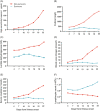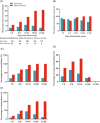Disease progression patterns and risk factors associated with mortality in deceased patients with COVID-19 in Hubei Province, China
- PMID: 32857453
- PMCID: PMC7461240
- DOI: 10.1002/iid3.343
Disease progression patterns and risk factors associated with mortality in deceased patients with COVID-19 in Hubei Province, China
Abstract
Background: Detailed descriptions of the patterns of disease progression of deceased coronavirus disease 2019 (COVID-19) patients have not been well explored.
Objectives: This study sought to explore disease progression patterns and risk factors associated with mortality of deceased patients with COVID-19.
Materials and methods: Epidemiological, clinical, laboratory, and imaging data (from 15 January to 26 March 2020) of laboratory-confirmed COVID-19 patients were collected retrospectively from two hospitals, Hubei province, China. Disease progression patterns of patients were analyzed based on laboratory data, radiological findings, and Sequential Organ Failure Assessment (SOFA) score. Risk factors associated with death were analyzed.
Results: A total of 792 patients were enrolled in this study, of whom 68 died and 724 survived. Complications during hospitalization, such as sepsis, severe acute respiratory distress syndrome, acute cardiac injury, and acute kidney injury, were markedly more frequent in deceased patients than in surviving patients. Deceased patients presented progressive deterioration pattern in laboratory variables, chest computed tomography evaluation, and SOFA score, while surviving patients presented initial deterioration to peak level involvement followed by improvement pattern over time. Days 10 to 14 after illness onset was a critical stage of disease course. Older age, number of preexisting comorbidities ≥2, and SOFA score were independently associated with death for COVID-19.
Conclusions: Multiorgan dysfunction was common in deceased COVID-19 patients. Deceased patients presented progressive deterioration pattern, while surviving patients presented a relatively stable pattern during disease progression. Older age, number of preexisting comorbidities ≥2, and SOFA score were independent risk factors for death for COVID-19.
Keywords: COVID-19; SARS-CoV-2; SOFA score; disease progression pattern.
© 2020 The Authors. Immunity, Inflammation and Disease published by John Wiley & Sons Ltd.
Conflict of interest statement
The authors declare that there are no conflict of interests.
Figures




Similar articles
-
Clinical characteristics of 113 deceased patients with coronavirus disease 2019: retrospective study.BMJ. 2020 Mar 26;368:m1091. doi: 10.1136/bmj.m1091. BMJ. 2020. PMID: 32217556 Free PMC article.
-
Clinical course and risk factors for mortality of adult inpatients with COVID-19 in Wuhan, China: a retrospective cohort study.Lancet. 2020 Mar 28;395(10229):1054-1062. doi: 10.1016/S0140-6736(20)30566-3. Epub 2020 Mar 11. Lancet. 2020. PMID: 32171076 Free PMC article.
-
Patient characteristics, clinical course and factors associated to ICU mortality in critically ill patients infected with SARS-CoV-2 in Spain: A prospective, cohort, multicentre study.Rev Esp Anestesiol Reanim (Engl Ed). 2020 Oct;67(8):425-437. doi: 10.1016/j.redar.2020.07.003. Epub 2020 Jul 13. Rev Esp Anestesiol Reanim (Engl Ed). 2020. PMID: 32800622 Free PMC article. English, Spanish.
-
Clinical Characteristics and Morbidity Associated With Coronavirus Disease 2019 in a Series of Patients in Metropolitan Detroit.JAMA Netw Open. 2020 Jun 1;3(6):e2012270. doi: 10.1001/jamanetworkopen.2020.12270. JAMA Netw Open. 2020. PMID: 32543702 Free PMC article. Review.
-
Coronavirus (Covid-19) sepsis: revisiting mitochondrial dysfunction in pathogenesis, aging, inflammation, and mortality.Inflamm Res. 2020 Nov;69(11):1077-1085. doi: 10.1007/s00011-020-01389-z. Epub 2020 Aug 7. Inflamm Res. 2020. PMID: 32767095 Free PMC article. Review.
Cited by
-
Vaccination status and outcomes of COVID-19 patients admitted to a tertiary hospital in Iran during the dominant Delta variant period.Immun Inflamm Dis. 2023 Feb;11(2):e790. doi: 10.1002/iid3.790. Immun Inflamm Dis. 2023. PMID: 36840484 Free PMC article.
-
Mortality in patients with Coronavirus disease 2019 (COVID- 19) and its clinicoradiological and laboratory correlates: A retrospective study.J Family Med Prim Care. 2022 Oct;11(10):6197-6203. doi: 10.4103/jfmpc.jfmpc_364_22. Epub 2022 Oct 31. J Family Med Prim Care. 2022. PMID: 36618193 Free PMC article.
-
Heterogeneity and Risk of Bias in Studies Examining Risk Factors for Severe Illness and Death in COVID-19: A Systematic Review and Meta-Analysis.Pathogens. 2022 May 10;11(5):563. doi: 10.3390/pathogens11050563. Pathogens. 2022. PMID: 35631084 Free PMC article. Review.
-
Hospital Length of Stay and Related Factors for COVID-19 Inpatients Among the Four Southern Regions Under the Proposed Southern Business Unit of Saudi Arabia.J Multidiscip Healthc. 2022 Apr 20;15:825-836. doi: 10.2147/JMDH.S362625. eCollection 2022. J Multidiscip Healthc. 2022. PMID: 35480062 Free PMC article.
-
Characteristics of Hospitalized COVID-19 Patients in the Four Southern Regions Under the Proposed Southern Business Unit of Saudi Arabia.Int J Gen Med. 2022 Mar 31;15:3573-3582. doi: 10.2147/IJGM.S357552. eCollection 2022. Int J Gen Med. 2022. PMID: 35386862 Free PMC article.
References
-
- Wold WSM, Ison MG. Adenovirus[M], eds. Fields Virology. 6th ed.: Lippincott, Williams & Wilkins; 2013:1732‐1767.
Publication types
MeSH terms
LinkOut - more resources
Full Text Sources
Medical
Miscellaneous

